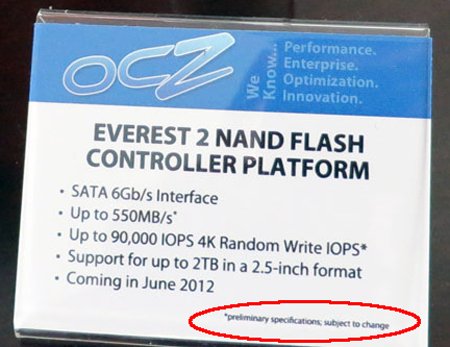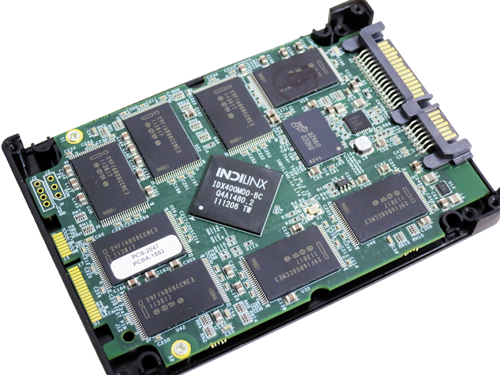OCZ Vertex 4 Review: A Flagship SSD Powered By...Indilinx?
OCZ's Vertex 4 Replaces An Already-Fast Flagship
Update: The praise heaped on OCZ’s controller technology was intended to recognize the company’s effort in making itself independent of third parties. However, a few weeks back, our friends at Xtreme Systems raised suspicions that OCZ’s Everest controllers (first- and second-gen) were actually based on Marvell logic. We were unable to confirm the validity of those claims until more recently, when OCZ acknowledged this to us.
The company’s official statement is as follows:
OCZ has a strong relationship with Marvell who we have collaborated with on both the Everest and Kilimanjaro platforms. Just as any product, a complete platform consists of many components, and in this case includes silicon that is run at higher speeds and Indilinx proprietary firmware, which was developed completely in-house, and allows OCZ to enable enhanced features, performance, and endurance. All of these elements come together to form the complete platform that can only be found in SSD products like the Octane and Vertex 4.
This puts the company in an interesting position, as it switches from one third-party controller company to another. It’s able to claim some benefits over other Marvell-oriented vendors on the hardware side, but puts most of its emphasis on the firmware work it has done. In the days to follow, we plan to dig even deeper on our own accord. And, if our research turns up anything interesting, you can count on a follow-up.
OCZ's Vertex 4, a drive that was first shown off at this year's CeBIT, is finally here. And it's based on the Everest 2 controller, first shown off earlier this year in Vegas at CES. More than just the company's new flagship SSD, the Vertex 4 represents OCZ's desire to stand apart in a business that's increasingly based on too few components integrated by too many vendors.
We saw OCZ introduce its first SSD based on SandForce's technology a couple of years back in the Vertex 2, followed more recently by a Vertex 3 employing a second-generation version of the controller firm's hardware. It was interesting to watch a relatively small company stand up to and outperform Intel, an organization that changed the face of storage with its own X25-M. But success as a SandForce partner was diluted by the fact that many competitors got access to the same controller silicon, creating their own interpretations of a recipe that OCZ so proudly presented just weeks earlier.
Today, only a handful of brands selling SSDs use their own controller hardware, NAND flash, and firmware. The rest source components and integrate them. Consequently, we see a lot of SandForce-based drives come through our lab. And not surprisingly, OCZ isn't eager to be lumped in with a long list of vendors manufacturing very similar products. There simply aren't enough ways to stand apart like that.
Get Tom's Hardware's best news and in-depth reviews, straight to your inbox.
In Search Of A Little Independence
Of course, SandForce deserves the recognition it receives for empowering vendors with the ability to manufacture low-cost, high-performance SSDs without needing to make an investment into controller technology (perhaps the most notable barrier to entry in solid-state storage). But the resulting likenesses between OCZ's own SandForce-based drives and everyone else's necessitated a change.
Recall that, a little more than one year ago, OCZ announced its intention to acquire Indilinx. Although the Korean company's prior work wasn't exactly celebrated in enthusiast circles, Indilinx's embedded/CE-oriented controller IP was most prominently mentioned in the announcement, suggesting a focus on mobile devices.
More recently, we were presented a 512 GB Octane drive based on Indilinx's Everest controller, and that SSD actually did manage to impress us. Its performance fell short of spectacular, hurting its overall value proposition. But we clearly saw that OCZ still intended to steer Indilinx toward the power user market.
Today, OCZ seems intent on driving that affirmation home. The Everest 2 controller it showed us at CES, successor to the Octane's engine, finds a home in an actual product...called Vertex 4. OCZ is so confident in its latest effort that it's making a conscious decision to succeed the already-fast Vertex 3 with something it considers to be even better.
Meet The Vertex 4, Based On Everest 2
Quite deliberately, OCZ is being coy about the innermost technical details of its Everest 2 controller. We do know, however, that its most notable features remain unchanged from the previous generation. Like its predecessor, Everest 2 is another eight-channel controller based on a dual-core ARM processor. It uses a discrete DRAM array to cache data and serve as a scratch space for clean-up operations.
And as with the previously-reviewed Octane, OCZ employs 64 Gb ONFi 2.2 NAND manufactured at 25 nm. It doesn't use any over-provisioning, either.
On our 256 GB sample, each of the 16 memory packages represents 16 GB of capacity (2 x 8 GB dies).
| Manufacturer Specifications @ 256 GB | OCZ Octane | OCZ Vertex 3 | OCZ Vertex 4 |
|---|---|---|---|
| NAND | 64 Gb 25 nm, ONFi 2.2 | ||
| 4 KB Random Read | 35 000 IOPS | 85 000 IOPS | 90 000 IOPS |
| 4 KB Random Write | 25 000 IOPS | 60 000 IOPS | 85 000 IOPS |
| 128 KB Sequential Read | 480 MB/s | 550 MB/s | 535 MB/s |
| 128 KB Sequential Write | 310 MB/s | 520 MB/s | 380 MB/s |
The difference in controller technology starts to emerge when you glance at OCZ's own specifications. Compared to Vertex 3, the drive being introduced today boasts higher IOPS, but lower sequential transfer performance (though it still surpasses the Octane's capabilities on all fronts).
| Vertex 4Manufacturer Specifications | 128 GB | 256 GB | 512 GB |
|---|---|---|---|
| DRAM Cache | 512 MB | 512 MB | 1 GB |
| 512 B Random Read | 120 000 IOPS | 120 000 IOPS | 120 000 IOPS |
| 4 KB Random Read | 90 000 IOPS | 90 000 IOPS | 95 000 IOPS |
| 4 KB Random Write | 85 000 IOPS | 85 000 IOPS | 85 000 IOPS |
| 128 KB Sequential Read | 535 MB/s | 535 MB/s | 535 MB/s |
| 128 KB Sequential Write | 200 MB/s | 380 MB/s | 475 MB/s |
Sequential write performance is the only specification that really varies as you scale up and down the three capacities that comprise OCZ's Vertex 4 family.
Current page: OCZ's Vertex 4 Replaces An Already-Fast Flagship
Next Page Test Setup And Benchmarks-
compton Octane was not a special and unique snowflake; Indeed, someone else's fingerprints were all over it. Vertex4 is certainly unique, but I fully expect the next round of drive launches using Marvell products to look like the V4, but possibly with some more balance.Reply -
billybobser Seems to good to be true.Reply
We'll see how they are once they've been out in the open for 6 months when problems will/will not flare up. -
maxinexus As Billy said only time will tell. These preliminary tests are great and pricing is better but still SSD are expensive...we need to get to cents not dollars per GB. Anyway good start OCZ...now the only thing you need is your own NANDs...perhaps in few yearsReply -
jgutz2006 This is a great step and makes financial sense for OCZ to come to market with a competitive product and possibly undercut all the others. Its a no brainer im my world. Force Samsung to sell units with less profit marginsReply -
Branden it'll be interesting to see how reliable these drives are and what their failure rate is going to be. OCZ's vertex 2 and 3 drives were horribly unreliable - in my experience 50% failure/DOA rate, my local shop said they see about 10% of them returned due to failure (and that's just within their 2 week return window alone).Reply
sorry OCZ, you've lost my business this time around. i've since replaced all my remaining OCZ SSD's with crucial m4's, they may not quite perform as well as your latest offerings but in my experience reliability > performance. -
JackNaylorPE When I built Son No.2 's box, we installed the Seagate Barracuda XT on Friday and measured boot times at 21.2 seconds to the Password entry screen. The Vertex 3 arrived on Monday and after installing that, we measured boot times at 15.6 seconds. Not commenting on the actual times as differences in hardware as well as testing parameters could push it in any direction, but what I will comment on is the HD choice for this test.Reply
My testing showed it took 36% extra time to boot off the HD instead of the HD. This test has it taking 226 % longer. If we're gonna test the best SSD's, I'd sure like to see a best in class HD added to the comparisons. -
burnley14 Brandenit'll be interesting to see how reliable these drives are and what their failure rate is going to be. OCZ's vertex 2 and 3 drives were horribly unreliable - in my experience 50% failure/DOA rate, my local shop said they see about 10% of them returned due to failure (and that's just within their 2 week return window alone).sorry OCZ, you've lost my business this time around. i've since replaced all my remaining OCZ SSD's with crucial m4's, they may not quite perform as well as your latest offerings but in my experience reliability > performance.It's interesting because so many people have talked about how unreliable they are, but in my personal experience (a small sample size, granted) I've been very pleased with both the Vertex 2's performance and reliability and the Agility 3's. Maybe I'm just lucky.Reply -
drwho1 all I read was: support for 2TB... *drooling*Reply
Price for 2TB SSD?
*not drooling anymore* -
OntarioHero Hmmm. Basically OCZ decided "Indilinx too slow! sod it, stick 1GB buffer in there!"Reply



